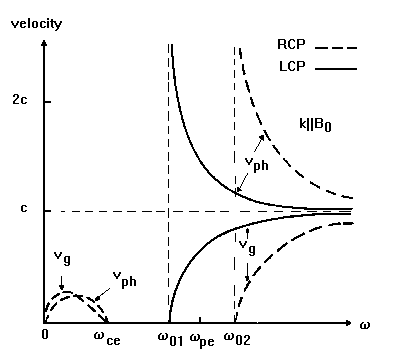 Waves in cold plasma
Waves in cold plasma
SpaceWeb@SkyNet.oulu.fi
- last update: 28 May 1995, 0800 UT
As discussed in context of plasma theories,
the thermal kinetic energy of plasma particles is ignored in cold plasmas.
In practice this means neglection of the pressure terms in the equations.
In the theory of waves, this approximation is
justified if the particle thermal
velocity is small when compared with the wave phase velocity.
Accordingly, for waves with very small phase velocities, warm plasma
theory must be used.
Another often used approximation is to consider only electron motion.
The theory of wave propagation in a cold homogenous electron gas immersed
in a magnetic field (B) is known as magnetoionic theory.
The neglection of ions is valid only for high frequency waves, i.e., for
frequencies large compared to the
ion cyclotron frequency. To go on to the next level of approximation,
the theory of high-frequency small-amplitude plane waves propagating in
an arbitrary direction with respect to B is called the
Appleton-Hartree theory. This was first developed to study wave
propagation in the Earth's ionosphere.
The restriction of small-amplitude waves makes it possible to use
linear perturbation theory, where the wave related variations in the
plasma parameters are small when compared to the undisturbed
parameters. The use of plane waves makes the equations easier, but
implyes no loss of generality, since any wave motion can always be
synthesized in terms of plane waves.
The hydromagnetic extension of magnetoionic theory deals
with multicomponent cold plasma.
In the cold electron gas, important variables are the electron number
density and the average electron velocity. They must satisfy
- the continuity equation,
- the Langevin equation of motion, and
- Maxwell's equations
The wave modes are found from the dispersion relation
calculated using the above equations.
We start investigating the results from a non-magnetized (isotropic) plasma,
before including the external magnetic field so important for space physics.
Ion motion is not included (but some remarks about ion effects are given).
Non-magnetized cold plasma
There are one oscillation mode and one real wave mode in cold isotropic electron
plasma:
- electron plasma oscillations
- longitudinal oscillations at electron plasma frequency w(pe)
- electrostatic and stationary (no wave propagation, but note:
warm plasma theory reveals the electron plasma waves
related to this oscillation)
- inclusion of ions in the cold wave theory
changes slightly the oscillation frequency: w=sqrt(w(pe)^2+w(pi)^2)
(we talk simply about longitudinal plasma oscillations)
- transverse waves
- propagating above the electron plasma frequency, w(pe) (reflection point for
the waves)
- note that, for very high frequencies, both phase and group velocities are
equal to light velocity c, and we have electromagnetic wave in free space:
even the electrons are unable to respond to the rapidly oscillating electric
field!
- also here the inclusion of ions into the theory changes the reflection
point frequency as above

Frequency dependence of the phase and group velocities for the transverse
waves in a collisionless isotropic cold electron plasma.
Magnetized cold plasma
Things get quite a bit more complicated when external magnetic field B
is taken into account (even with the Appleton-Hartree approximation):
Propagation parallel to B (three wave modes)
- longitudinal electron plasma oscillations (as for isotropic plasma)
- transverse right-hand circularly polarized waves, RCP
- the transverse electric field of the wave rotates in the same direction as the
electrons about the B field
- at electron gyrofrequency, a resonance
is created, and energy is transformed from the wave to the electrons
- plasma electrons can be heated with this method
- waves propagate in two frequency ranges: w<w(ce) and w>w(02)
- RCP waves at lower frequencies than the electron gyrofrequency w(ce) are commonly
known as electron cyclotron waves
- at very low frequency region (but well above the w(ci))
whistler waves are found
- transverse left-hand circularly polarized waves, LCP
- if ion motion is not taken into account, LCP waves propagate only when w>w(01)
- if ion motion is taken into account, w<w(ci) branch is created
- resonance is created with ions
- ion cyclotron waves are found

Frequency dependence of the phase and group velocities for the transverse RCP and
LCP waves propagating along magnetostatic field in a collisionless cold electron plasma.
An important point is that, in the very low frequency limit, the phase velocities of the RCP
and LCP waves (if ion motion is included) go to zero. This means that in order to get Alfven
waves (see MHD waves) one has to use warm plasma theory,
where the low frequency phase velocity is, approximately, Alfven velocity.
Propagation perpendicular to B (two wave modes)
- ordinary waves
- identical to transverse waves in an isotropic plasma, i.e., the propagation is not
affected by B
- propagating above the electron plasma frequency, w(pe)
- also here the reflection point frequency is affected by ions
- also called TEM (Transverse Electric-Magnetic) mode, since both the electric and
magnetic fields are transverse to the direction of propagation (linear polarization)
- extraordinary waves
- waves propagate in two frequency ranges: w(01)<w<w(UH) and w>w(02)
- also called TM (Transverse Magnetic) mode, since the magnetic fields are transverse
to the direction of propagation
- electric field can have a longitudinal component (along k): these waves are
thus partially longitudinal and partially transverse (elliptically polarized)
- if ion motion is taken into account, w<w(LH) branch is created; this branch
relates to the low frequncy MHD (Alfven) waves.
Propagation at arbitrary directions
We are not going into details here (perhaps later)!
A phenomenon known as Faraday rotation occurs in the frequency range of RCP
and LCP waves, and can be used as a plasma diagnostic tool.
See also:
 Waves in cold plasma
Waves in cold plasma Waves in cold plasma
Waves in cold plasma
